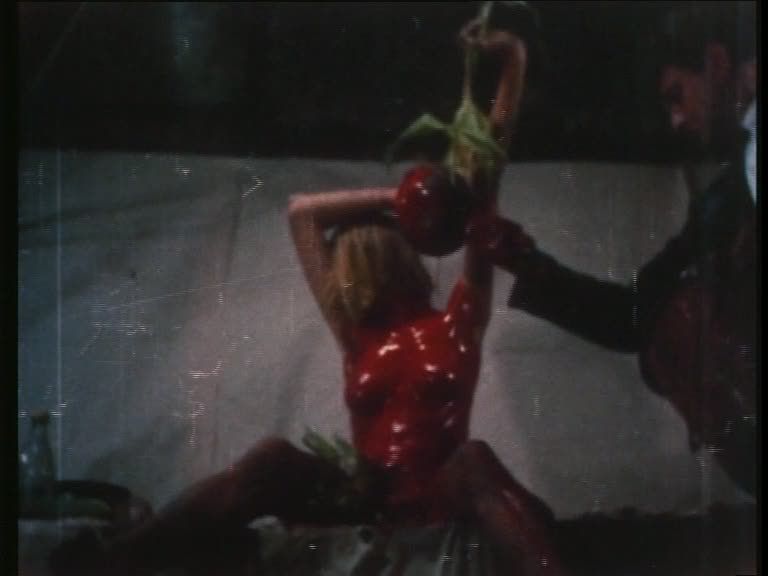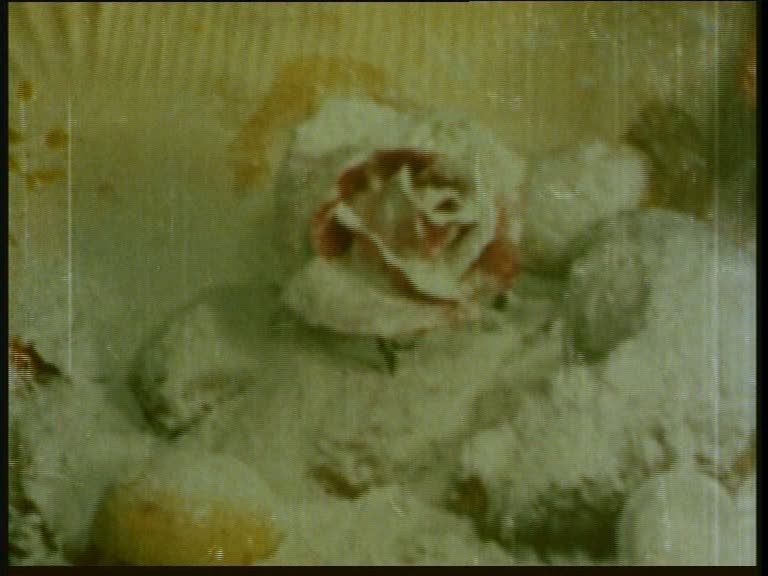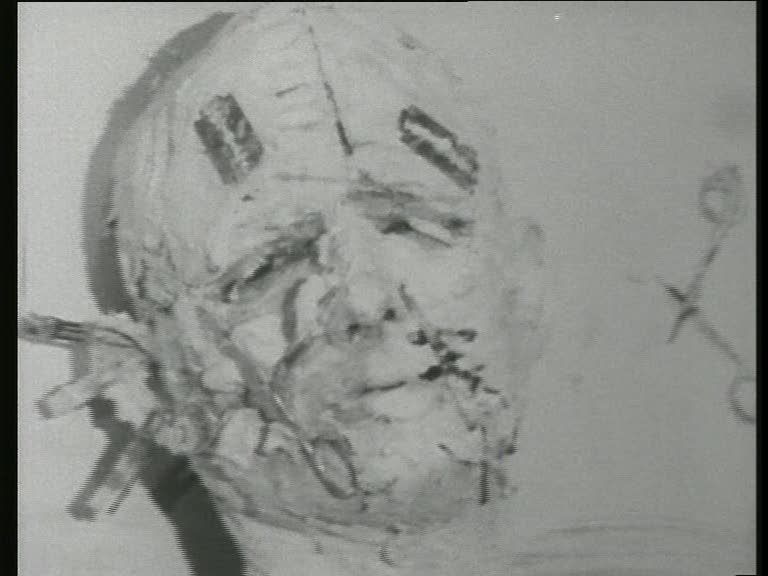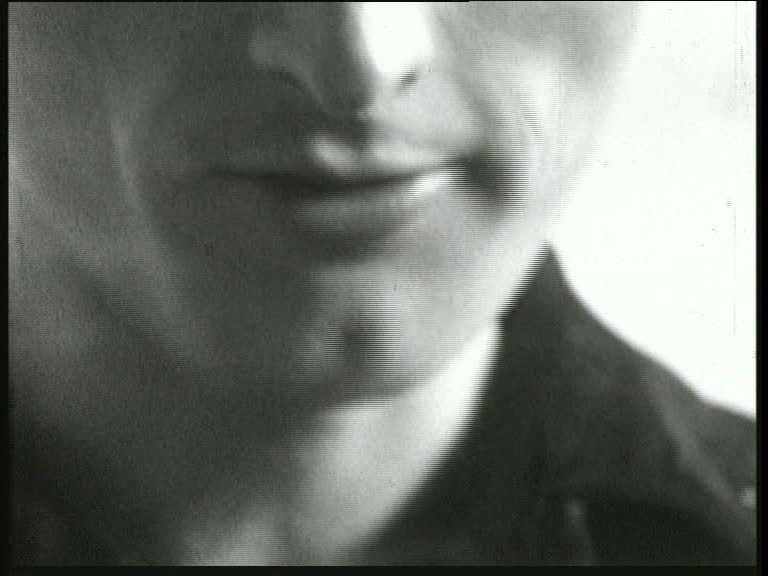
During the mid-1960s, Austrian experimental filmmaker Kurt Kren became momentarily associated with the confrontational performance art of the Vienna Aktionists, primarily Otto Mühl (who would later contribute to Dušan Makavejev's great Sweet Movie) and Günter Brus. Mühl and Brus specialized in bizarre "materialaktions" in which they would act upon the human body with paint and food products, creating messy, perverse spectacles in which sexuality, bodily functions and physicality were foregrounded and explored. In 1964, Kren began filming some of these aktions, though he was not interested in being a documentarian. Instead, he took the raw materials of Mühl and Brus' aktions and acted upon them himself, creating new works through the formal exploration of the images he gathered at these events. The results often infuriated the two provocateurs, who had desired a more straightforward documentary record of their work — Mühl would eventually begin filming his performances himself instead — but Kren's raw, ragged films nevertheless capture the intense spirit and unfettered physicality of this scene, while crafting these images into entirely new works of his own.
His first film in this vein was Mama und Papa, based on an aktion by Mühl. This first film sets the tone for Kren's work with the Aktionists, and especially for the color films he made with Mühl. The editing is hyper-fast and fragmentary, and carefully cycles through the same shots in a rhythmic pattern, returning again and again to the same images. This pulsating repetition shatters the cause-and-effect chains of Mühl's aktion, but preserves its subversive power. This aktion, as with most of Mühl's performances, consists primarily of nude models being coated with paint or food, their bodies carefully arranged and posed as though molding inanimate objects. Mühl methodically lays out his arrangements of flesh and viscous materials, focusing on the interactions of colors and forms, as though he were a painter working with the human body as his canvas. Kren's film limns the visceral qualities of Mühl's work; the sense of disgust is palpable, as is a feeling of profound discomfort. One can't help but see these films and imagine the sensations: the stickiness and sliminess of the liquids, dripping off the participants' bodies, puddling on the floor around them.

And yet Kren's films also demonstrate that Mühl's work goes beyond such confrontation, beyond the sensations of disgust. There's a kind of childishness to these performances as well, an innocence that seems rooted in childhood games, in mud pies and sand boxes. This spirit of play is perhaps most apparent in O Tannenbaum, also derived from a Mühl aktion, a ludicrous Christmastime farce in which Mühl arranges his actors with Christmas trees protruding from their asses. Working like a flower arranger or a gourmet chef, he carefully lays out assortments of eggs and sausages around a man's penis, then tops it with a flower — or places a pair of toy glasses over the penis as though it were a nose. There's a goofiness to much of this work, a loose spirit of improvisation that works against the notes of menace and exploitation and deviant sexuality also running through Mühl's work. These two threads tangle together in his films, much as his performances tangle together human bodies into indiscriminate masses of limbs and torsos, dehumanized canvases to be acted upon.
Kren takes this ethos further by acting upon the footage, abstracting it from its origins and the ideas of his collaborators. By chopping up Mühl's aktions into blurred, frantically edited montages, he reduces them to their visceral essence. In O Tannenbaum, what remains is a brilliant sense of color, the bright reds and greens of the Christmas season being sprayed onto bodies in violent slashes of color. Of Kren's Mühl films, only his last, Cosinus Alpha, slows the action down enough to make it more coherent, rather than treating it as material for montage. At 9 minutes long, it is also the longest of the Aktionist films, and its pace seems positively languid in comparison to the others. What comes across here is a sense of the erotic and the sexual in Mühl's work, a dimension of his performances largely missing in Kren's other films, despite the copious nudity. Here, the camera's relative steadiness, and the slow, deliberate movements, emphasize the sensual contact of flesh on flesh, the rubbing and caressing as bodies rub against one another, covered in thick soupy muck, kneading the liquids into one another's skin.
This sensuous film emphasizes the pleasurable aspects of Mühl's performances, especially since it's apparent that his models are not simply passive in this instance, but are actively engaging with one another, and with the mess that covers them, seemingly taking pleasure in wallowing in each other so messily.

The other major thread in Kren's Aktionist films was his interaction with Mühl's colleague Günter Brus. Brus' work is quite different from that of his contemporary, and as a result Kren's films are different as well. Whereas all of his Mühl films were in bright color, glorying in the eye-catching palette of these aktions, the Brus films are all in black and white and decidedly more abstract, distanced from the concrete reality of the event being captured. If Mühl's aktions are messy and sexualized and all more or less the same, Brus seems to be more conceptual, more varied, and probably more interesting in his own right — his works captured here seldom seem to be simple exercises in sloppy play, but are instead rigid engagements with conceptual re-imaginations of the human body.
Kren's films sometimes make Brus' work hard to grasp, however, because even more so than with the Mühl films, these films atomize and break down the continuity of the event itself. Ana was the first film Kren made with Brus, and it's seldom even clear what's actually going on here. There are flashes of movement and occasional moments of clear activity, but for the most part the action is an indistinct blur, rapidly flitting across the frame. For much of the film, Kren's choppy cutting approaches the impressionistic pixelization of Stan Brakhage's painted films: black forms dancing across a plain white field, shifting and vibrating from frame to frame, seldom resolving into anything representational. This approach is as viscerally stunning as Kren's treatment of Mühl's work, but seems to have wandered even further afield from the content of the work itself. In Silber, Kren's abstractions progress even further, to the point where virtually the entire film takes place in a vague, under-exposed darkness. It is perhaps the weakest film in this set, the one film where Kren's refusal to provide a faithful documentary account results in a loss of any context or even content; all that remains is the form, the pace of the editing.

Fortunately, the strongest film in this set is another of Kren's collaborations with Brus, the harrowing Self-Mutilation. For this aktion, Brus coated himself with a viscous paste, rolled around on the floor, and subjected himself to simulated (and probably some amount of genuine) mauling with scissors, razors, pins, clips, corkscrews and knives. It is an expression of anguish in its purest form. Brus' face and body, covered with a thick porridge-like substance, are reduced in their entirety to his mouth, perpetually open in a scream or a cry, and his eyes, staring fearfully out of the muck accumulated on his face.
Kren responds to this performance by concentrating on Brus' face, on the expressions of terror, pain and despair that are communicated solely through the eyes and mouth, with everything else reduced to a lumpy gray landscape. The pace is much slower than in Kren's other films, the shots longer, so the emphasis remains on the performance itself as it does in few of his other Aktionist works. This is perhaps the Aktionists' ultimate statement, the simplification of human emotion to a primal scream, eyes pleading and a mouth opened in a silent howl, unable to communicate, unable to forge deeper connections, unable to get beyond one's own body and the pain it feels. This is a startling, terrifying portrait of imprisonment within the cage of the body: a man trapped by his own sensations, self-imposed and yet unavoidable. The film takes place almost entirely in closeups of Brus' face, essentially trapping the audience along with this sufferer. Kren's camera frequently goes out of focus, capturing the wild-eyed Brus as he flails about, his face contorted, his hands scraping at the coating on his skin. The filmmaking is simple and direct, a perfect accompaniment to this performance's terrifying straightforwardness.

After Kren ended his association with Mühl and Brus, he returned to the formalist experiments he'd been making prior to this brief Aktionist period; this was the filmmaking mode that would define the remainder of his career. Before he fully ended his collaborations with the Aktionists, however, he made one last film in this vein. 20. September, unlike the other Aktionist films, is not a document of an aktion, but is instead a true collaborative work in which Brus is more or less an "actor" for Kren. The film has been charmingly nicknamed the "Eating, Drinking, Pissing and Shitting film," and that title pretty much announces what one is in for here. This disturbing, difficult-to-watch film takes the Aktionists' exploration of the body to its extreme resolution, simplifying the "plot" of a film to the four simple bodily processes that form the basic bedrock of human existence. Along with breathing and sleeping, these are the necessities of life, the things that humans must do in order to live, to survive and thrive. Kren films each of these processes in intimate closeups: images of Brus' mouth as he drinks a beer or shovels food into his mouth, intercut with straight-on images of a penis emitting a steady stream of urine and an anus opening up to allow the feces to crawl slowly out.
There is no possible reaction to a film like this but visceral disgust and discomfort, and that seems to be the primary intent. Its point is a simple one, and it achieves it by juxtaposing both ends of the processes by which we sustain our lives: drinking ends in pissing, and eating ends in shitting. Unlike the films crafted from actual Aktionist performances, this film seems to work on one level only, and once its essential point is understood — which happens pretty quickly — all it has to offer is the repetition of its message of disgust. However disturbing and gross the other Aktionist films are, however much they wallow in filth and disgusting images, they are always more multi-faceted than this, always more complicated in the juxtapositions of sexual feelings, disgust, playfulness and subversion of the norm.
Kren's collaborations with Mühl and Brus yielded a body of work that, while perhaps peripheral to Kren's later work as a formalist and structuralist innovator, is still interesting in its own right. It's the rare piece of provocation and controversy that retains its power over 40 years after it originally appeared, but that certainly applies to these unsettling films.

2 comments:
I wish I could say more here, but alas, I am completely unfamiliar of any of these. I have read your review though, and have come away with a marked interest, especially in SELF-MUTILATION.
Kurt was a close friend in the Usa in the 80's and 90's and my bodyguard at some punk film events in San Francisco and I have many many stories
Post a Comment